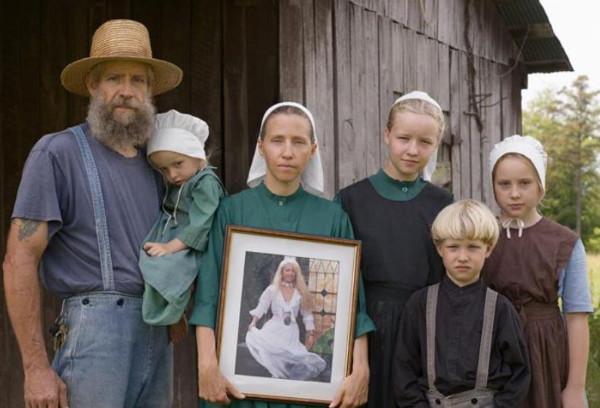Mennonites
Mennonites. A religious-cultural group whose adherents represented a large portion of the settlers colonizing the southern Ukrainian steppe in the late 18th to early 19th century. Founded in the 16th century by Menno Simons as an outgrowth of the Anabaptists, the group was notable for certain social practices, particularly its refusal to swear oaths and its rejection of military service. Until the late 18th century the major concentrations of Mennonites were found in tightly knit rural agrarian communities in southern Germany, the Vistula River basin in Poland, and the Netherlands. The prospect of increased religious persecution in Germany and Poland led the Mennonites to consider the possibilities of settling in the recently opened lands of Southern Ukraine. This prospect was made especially attractive by Catherine II's decree of 1763–4 that guaranteed generous financial incentives, religious freedom, and exemption from military service for foreign settlers in the area. In 1789 the first group of Mennonites in Ukraine settled near the former stronghold of the Cossacks on the Khortytsia Island, in Katerynoslav gubernia. Subsequent Mennonite settlers established a second colony southeast of Khortytsia near the Molochna River. By 1835 there were approximately 1,600 Mennonite families located in 72 colonies in Katerynoslav gubernia and Tavriia gubernia. By 1911 there were 104,000 Mennonites in Southern Ukraine, constituting 19.2 percent of the German population (see Germans) in that region. As well, a small number of Mennonite colonies were formed in Samara gubernia and Caucasia region.
The Mennonites prospered in Ukraine. They acquired significant landholdings and worked them as model farmers. They also developed extensive flour milling interests in southern Ukraine as well as the manufacture of agricultural machinery. The Mennonites were not assimilated into Ukrainian society because of both their conscious attempts to maintain a cohesive society of their own and the desire of tsarist authorities to keep them isolated from other social groups. Their most extensive interaction with Ukrainians was as employers of farm laborers. In general Ukrainians regarded the Mennonites as being fair in their business dealings, and they benefitted indirectly from the agricultural techniques learned from them.
The Mennonites' political fortunes took a turn for the worse during the 1870s, in part as a result of the souring of relations between the Russian Empire and Germany. In 1871 the codex under which they had colonized Ukraine was revoked. The Mennonites lost their administrative autonomy, were required to use Russian as the language of instruction in schools, and (from 1874) were expected to perform noncombatant military service. A large portion of the Mennonite population of Ukraine then emigrated to North America; those from the Khortytsia Island region generally favored Canada, and those from the Molochna River valley, the United States. Others moved to more remote regions of the Russian Empire. Mennonites, as other minorities, suffered greatly during the revolutionary upheavals of 1917–20 (see Revolution of 1917; Ukrainian-Soviet War, 1917–21). The major tribulations of the Mennonites, however, occurred after the establishment of the Soviet regime, which took over control of education and closed down Mennonite churches, the basis of their community life. A concerted effort by worldwide Mennonites allowed some of their coreligionists to emigrate from the Soviet Union in the 1920s, most notably a group of nearly 20,000 who settled in western Canada. The Mennonites suffered further losses during the Soviet collectivization campaign (when many were deported to Siberia as kulaks), the Famine-Genocide of 1932–3, and the Stalinist terror (when many of their religious leaders were imprisoned). The final blow to the community in Ukraine came during the Second World War, when Mennonites were evacuated eastward in 1941 before advancing German troops, and westward in 1943 before the advancing Soviet Army. The Mennonite colonies in Ukraine were effectively dismembered in the process and never reconstituted. Some of the Mennonite refugees who found themselves in Germany after the war were resettled in North and South America. The majority, however, were repatriated and either imprisoned or resettled in Western Siberia and Central Asia (see Repatriation and Resettlement). Those who survived were released in the mid-1950s but denied permission to return to Ukraine. Most Mennonites had emigrated from the USSR by 1985.
BIBLIOGRAPHY
Rempel, David. ‘The Mennonite Colonies in Russia: A Study of Their Settlement and Economic Development from 1789 to 1914’ (PH D diss, Stanford University, 1933)
Epp, Frank. Mennonite Exodus (Altona 1962)
Friesen, Paul. The Mennonite Brotherhood in Russia, 1789–1910, trans and ed John Toews et al (Fresno 1978)
Stumpp, Karl. The German-Russians: Two Centuries of Pioneering, trans Joseph Height (New York 1978)
Epp, George. ‘Mennonite-Ukrainian Relations (1789–1945),’ Journal of Mennonite Studies, 7 (1989)
Friesen, John. Mennonites in Russia, 1788–1888 (Winnipeg 1989)
Dyck, Harvey L. (ed and trans). A Mennonite in Russia: The Diaries of Jacob D. Epp, 1851–1880 (Toronto 1991)
Andrii Makuch
[This article originally appeared in the Encyclopedia of Ukraine, vol. 3 (1993).]

.jpg)
.jpg)
